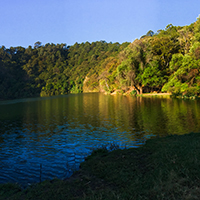Seasonal variation of Microcystis aeruginosa and factors related to blooms in a deep warm monomictic lake in Mexico

Accepted: 23 April 2021
Supplementary: 91
HTML: 21
All claims expressed in this article are solely those of the authors and do not necessarily represent those of their affiliated organizations, or those of the publisher, the editors and the reviewers. Any product that may be evaluated in this article or claim that may be made by its manufacturer is not guaranteed or endorsed by the publisher.
Authors
The occurrence of cyanobacterial blooms has increased globally over the last decades, with the combined effect of climate change and eutrophication as its main drivers. The seasonal dynamic of cyanobacterial blooms is a well-known phenomenon in lakes and reservoirs in temperate zones. Nevertheless, in the tropics, most studies have been performed in shallow and artificial lakes; therefore, the seasonal dynamic of cyanobacterial blooms in deep and eutrophic tropical lakes is still under research. We studied the seasonal variation of the phytoplankton community and the factors associated with Microcystis aeruginosa blooms along the water column of Lake Alberca de Tacámbaro, a warm monomictic crater lake located in Mexico, during 2018 and 2019. According to previous studies performed in 2006 and 2010, this lake was mesotrophic-eutrophic, with Chlorophyta and Bacillariophyta as the dominant groups of the phytoplankton community. During 2018 and 2019, the lake was eutrophic and occasionally, hypertrophic, a phenomenon likely associated with the increase of farmland area around the lake. The dominant species was M. aeruginosa, forming blooms from the surface to 10 m depth in winter, in the hypolimnion in spring and summer, and along the full water column in autumn. These findings suggest that M. aeruginosa in Lake Alberca de Tacámbaro displays seasonal and spatial population dynamics. Total phosphorus, dissolved inorganic nitrogen, water temperature and photosynthetically active radiation were the environmental factors related to M. aeruginosa blooms. Our results suggest that the changes in the structure of the phytoplankton community through time, and M. aeruginosa blooms in Lake Alberca de Tacámbaro, are mainly related to changes in land use from forest to farmland in areas adjacent to the lake, which promoted its eutrophication in the last years through runoffs. Comparative studies with other deep and eutrophic lakes will allow us to gain a deeper understanding of the dynamic of cyanobacterial blooms in natural and artificial water reservoirs strongly stressed by human activities.
Edited by
Diego Fontaneto, CNR-IRSA Water Research Institute, Verbania, ItalyHow to Cite

This work is licensed under a Creative Commons Attribution-NonCommercial 4.0 International License.
Similar Articles
- Anna BEDNARSKA, Joanna ŁOŚ, Piotr DAWIDOWICZ, Temperature-dependent effect of filamentous cyanobacteria on Daphnia magna life history traits , Journal of Limnology: Vol. 70 No. 2 (2011)
- Soumaya EL HERRY, Hichem NASRI, Noureddine BOUAÏCHA, Morphological characteristics and phylogenetic analyses of unusual morphospecies of Microcystis novacekii forming bloom in the Cheffia Dam (Algeria) , Journal of Limnology: Vol. 68 No. 2 (2009)
- Jennifer B. KOROSI, Andrew M. PATERSON, Anna M. DESELLAS, John P. SMOL, Linking mean body size of pelagic Cladocera to environmental variables in Precambrian Shield lakes: A paleolimnological approach , Journal of Limnology: Vol. 67 No. 1 (2008)
- Iván A. Meza-Matty, Gorgonio Ruiz-Campos, Luis Walter Daesslé, Arturo Ruiz-Luna, Álvaro Alberto López-Lambraño, Faustino Camarena-Rosales, Kathleen R. Matthews, Daily, seasonal, and annual variability of temperature in streams inhabited by the endemic San Pedro Martir trout (Oncorhynchus mykiss nelsoni), in Baja California, Mexico, and the predicted temperature for the years 2025 and 2050 , Journal of Limnology: Vol. 80 No. 2 (2021)
- Walter AMBROSETTI, Luigi BARBANTI, Physical limnology of Italian lakes. 1. Relationship between morphometry and heat content , Journal of Limnology: Vol. 61 No. 2 (2002)
- Alfredo Schiavon, Claudio Comoglio, Alessandro Candiotto, Franz Hölker, Muhammad Usama Ashraf, Daniel Nyqvist, Survival and swimming performance of a small-sized Cypriniformes (Telestes muticellus) tagged with passive integrated transponders , Journal of Limnology: Vol. 82 (2023)
- Raffaele Peduzzi, Renata Boucher-Rodoni, Wolfgang Geiger (17 July 1921 - 3 July 2000) , Journal of Limnology: Vol. 59 No. 2 (2000)
- Rosario MOSELLO, Aldo MARCHETTO, Maria C. BRIZZIO, Michela ROGORA, Gabriele A. TARTARI, Results from the Italian participation in the International Co-operative Programme on Assessment and Monitoring of Acidification of Rivers and Lakes (ICP Waters) , Journal of Limnology: Vol. 59 No. 1 (2000)
You may also start an advanced similarity search for this article.
-
Richard Mugani, Fatima El Khalloufi, Minoru Kasada, El Mahdi Redouane, Mohammed Haida, Roseline Prisca Aba, Yasser Essadki, Soukaina El Amrani Zerrifi, Sven-Oliver Herter, Abdessamad Hejjaj, Faissal Aziz, Naaila Ouazzani, Joana Azevedo, Alexandre Campos, Anke Putschew, Hans-Peter Grossart, Laila Mandi, Vitor Vasconcelos, Brahim OudraHarmful Algae : 2024
-
Gerardo Ávila-Torres, Gabriela Rosiles-González, Victor Hugo Carrillo-Jovel, Gilberto Acosta-González, Eduardo Cejudo-Espinosa, Daniela Ortega-Camacho, Cecilia Hernández-Zepeda, Oscar Alberto Moreno ValenzuelaMicrobiology Research : 2023
-
Daisy Valera Fernández, Beatriz Ortega Guerrero, Elizabeth Solleiro Rebolledo, Cecilia Irene Caballero MirandaGeofísica Internacional : 2024

 https://doi.org/10.4081/jlimnol.2021.2013
https://doi.org/10.4081/jlimnol.2021.2013





